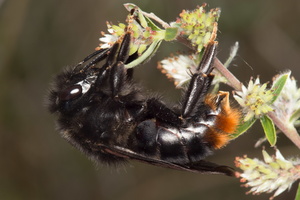- sort orderDefault
Photo title, A → Z
Photo title, Z → A
✔ Date created, new → old
Date created, old → new
Date posted, new → old
Date posted, old → new
Visits, high → low
Random - Google Map
- map
 home / Insecta · vabzdžiai / Hymenoptera · plėviasparniai / Apidae · bitės / Bombus rupestris · juodoji gegutkamanė
home / Insecta · vabzdžiai / Hymenoptera · plėviasparniai / Apidae · bitės / Bombus rupestris · juodoji gegutkamanė

Bombus rupestris · juodoji gegutkamanė
- Psithyrus rupestris
- Hill Cuckoo Bumble bee, Red-tailed Cuckoo Bee
- Felsen-Kuckuckshummel
- juodoji gegutkamanė
- akmeņu parazītkamene
- trzmielec czarny
- bwars.com/bee/apidae/bombus-rupestris
- en.wikipedia.org/wiki/Bombus_rupestris
- naturespot.org.uk/species/hill-cuckoo-bee
Bombus rupestris present in most of Europe except Iceland. In the Balkans it is found in montane and alpine habitats northwards from Central Greece. It is also found in Turkey.
The female is much larger than the male; she has a length of 20–25 mm, while the drone usually is not more than 16 mm. The bumblebee is black, with the last abdominal segments coloured orange-red. Female wings are suffused dark brown. Males are smaller with clear wings and many have some dull yellow hairs on the front of the abdomen and on both the front and rear of the thorax. These yellow hairs, however, do not form a distinct band.
Due to its parasitic lifestyle, no workers exist. Bombus rupestris is found in flower-rich habitats, such as meadows and along hedgerows. The bumblebee parasitizes the nests of the red-tailed bumblebee, B. lapidarius, whose queen is killed or subjugated.
Išvaizda panaši į akmeninę kamanę (B. lapdarius), kurios lizduose ir parazituoja. Tai vienitelė gegutkamanių rūšis, kurios trys paskutiniai pilvelio tergitai yra apaugę rusvai raudonais plaukeliais. Paskutinio pilvelio sternito gale šoninės lysvelės sudaro iškilų kampą. Sparnai juosvai pilkšvi. Patelės stambios, nuo 20 iki 25 mm ilgio, patinėliai menkesni – 15–17 mm. Šios gegutkamanės lanko ežeinių, dagių, bajorių, čiobrelių, viržių, dobilų, rečiau kitų augalų žiedus. Tai eurosibirinė rūšis. Aptinkama visoje Europoje iki 62° šiaurės platumos, žinoma Kaukaze, Mažojoje Azijoje, Sibire. Lietuvoje ši rūšis randama gana dažnai, nevengia ir žmogaus kaimynystės.
Tamutis, Vytautas & Straigis, Justinas & Amšiejus, Algirdas. (2010). Kamanės (The bumblebees). 10.13140/2.1.1661.5369.

